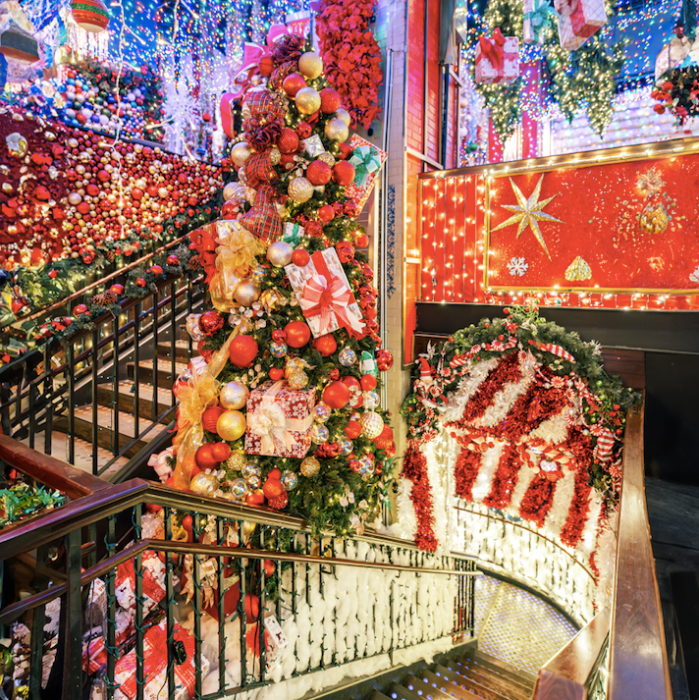Developers of a proposed casino and hotel complex next in Hell’s Kitchen laid out a sweeping vision for Manhattan’s far West Side during the first of two public hearings on Wednesday, pledging affordable housing, new jobs, community amenities, and an NYPD outpost as they seek one of the city’s coveted downstate gaming licenses.
The project drew support from unions, business groups, and most residents, but some locals resisted, saying they were not ready to gamble on the neighborhood’s future.
The Avenir, backed by Silverstein Properties, Rush Street Gaming, and Greenwood Gaming & Entertainment, would include a 1,000-room Hyatt hotel, a dozen restaurants, a food hall, and a casino occupying about 12% of the project footprint.
At its first public hearing on Aug. 27 at the Javits Center, the six-member Community Advisory Committee (CAC), appointed by city and state officials, heard from developers first, who stressed that the planned complex is intended to blend into the neighborhood rather than dominate it.
The project is one of eight proposals vying for three downstate licenses. If it secures a two-thirds majority vote from the CAC, it will move forward to the Gaming Facility Location Board for further review.
Lisa Silverstein, chief executive of Silverstein Properties, told the CAC that the company would build 2,000 new apartments, including 500 permanently affordable units. She said the project would rise on a vacant lot, avoiding demolition or displacement.
“This is a community we care deeply about,” Silverstein said. “Our site is fully zoned and shovel-ready. There is no converting, tearing down, rezoning, or moving tenants around that’s required. It’s an empty lot in a low-density area.”
“This area of the west side needs the economic drivers to further transform this neighborhood, activating it with more vibrant life and commerce, all of which brings more safety.”


Developers said community feedback shaped parts of the plan, stating that a new food hall inside the complex would aim to replace the recently closed Gotham West Market food hall.
Nancy Ruddy, of CetraRuddy Architecture, described plans for wide sidewalks, landscaped plazas, and a 42-foot-high community gallery space along 11th Avenue. She said the design prioritizes pedestrian circulation, with two glass elevators offering public access to upper floors without entering the casino.
“The Avenir will knit together the fabric of this part of the far West Side,” Ruddy said, noting connections to nearby hubs like Hudson Yards, Madison Square Garden and the Hudson River waterfront.
They also argued the project could revive a long-stalled 10th Avenue subway stop at 41st Street. They projected that the Avenir would generate $3 billion in direct MTA revenue in its first decade and an additional $4 billion in tax revenue for the city.
“We believe the Avenir would present the best chance of getting the MTA to deliver a subway station in that location, and would be the best amenity in the area. We were able to get the MTA to provide a subway station at 30 Park Place in Tribeca, and we hope to be change makers, once again, bettering our community,” Silverstein said.
Regarding the residential units, Silverstein Properties Chief Operating Officer Dino Fusco said the apartments would all be located within or immediately adjacent to Community Board Four, within Council Member Eric Bottcher’s district.
Fusco said a study of the district is currently underway, and “we’ve identified many opportunities that we are actively pursuing.” According to the presentation, of the 306 buildings under consideration for conversion, 92 have been deemed feasible while 182 are still pending review.

Traffic and Safety
Environmental consultant Connor Lacefield, of AKRF, claimed a draft impact statement found no significant negative effects in 19 of 22 areas studied. However, he said vehicle trips tied to the project would increase traffic in the area by about 2%, spread across the day rather than during rush hour.
To limit car use, the proposal includes restricted on-site parking, a dedicated loading dock and a free 24-hour shuttle system to Penn Station, Grand Central Terminal, and Hudson Yards. Developers estimate the shuttles could handle about 8,000 riders daily.
He added that traffic studies flagged minor delays at 10th Avenue and 42nd Street and 11th Avenue and 42nd Street, but consultants said those impacts could be mitigated with signal timing adjustments.
“The site circulation is designed to keep traffic moving around the site,” Lacefield said. “To begin with, there is very limited parking, which discourages vehicle trips to the site. The building has also been designed with a driveway and porte cochère that brings traffic into the site for pickups and drop-offs and maintains traffic flow on 41st street.”
“Along 40th Street, the loading dock has been designed to support head-in and head-out operations, and it includes queuing space for trucks inside the dock. This ensures that trucks don’t impede traffic on 40th Street or on the sidewalk,” he added.
Bill Dicento, head of security for the project, outlined a five-point plan anchored by an on-site NYPD substation staffed with on-duty officers. He said the outpost would provide a visible police presence and rapid response.
The plan also calls for 300 private security staff, with 30 assigned to 24/7 perimeter patrols, onsite EMTs, upgraded lighting, over 50 surveillance cameras, and funding for a neighborhood ambassador program. Developers said they would also support outreach programs focused on homelessness, mental health, and human trafficking prevention.
Rush Street Gaming executives touted that their casinos in Philadelphia, Pittsburgh, and Schenectady did not lead to crime spikes and instead boosted local economies. They projected the Avenir would create 4,000 union construction jobs and 5,000 permanent jobs, with a median wage of $50 an hour.
Dawn Reynolds Pettit, Rush Street’s chief human resources officer, stressed that the Avenir will offer training and career development programs in hospitality, food service, IT, security, and other fields, saying they had already produced hundreds of promotions and job transfers at other Rush Street properties.
Support stacks the deck, skeptics still at the table

A total of 109 speakers provided feedback on the presentation, a majority of whom gave it a warm reception, including unions, business groups, and residents. But some locals were not sold.
Peter Myers of the Building and Construction Trades Council testified in support, calling the casino “an enormous economic benefit” that would create union jobs with “good wages, medical and retirement benefits.” Grace Capobianco, founder of Downtown Magazine, praised the Silverstein family’s track record, saying the project would “transform an underutilized area near the Javits Center into a vibrant destination.”
Supporters also pointed to community benefits. Chris, a lifelong New Yorker from the Upper West Side, said the project would fill “a giant hole in the ground” and bring “connectivity and life into an area that right now just feels very disconnected.”
Matt J., head of nonprofit Rethink Food, said the developers were the only casino bidders to approach his group about food insecurity, offering to “make as many meals for low-income New Yorkers as possible.”
But opponents warned the casino would erode the quality of life in Hell’s Kitchen. “Please, please don’t build this casino,” said Brian, a 43rd Street resident. “Casinos are built to keep people inside, losing money… Local businesses will be driven out.”
Others raised concerns about schools and children. “There are two schools right down the block,” said longtime resident Jacqueline Lowry. “We don’t need a casino. We need a supermarket.”
Allison, a parent in the neighborhood, argued that the project would flood already dangerous intersections with cars just as kids are leaving school: “Corners are already dangerous… I hear you talking about traffic. I don’t hear you talking about kids.”
Liz Keith, who has lived two blocks from the site for nearly four decades, said congestion pricing had finally brought relief to 10th Avenue traffic, but the casino risked undoing that progress. “It’s kind of a pie-in-the-sky idea to think that [visitors] are going to take public transportation,” she said.
Joel Jones, another Hell’s Kitchen resident, criticized the process: “I want to find out who invited you to Hell’s Kitchen. I’m not aware of anyone in that neighborhood having been informed about your plans until quite recently.”

Silverstein’s COO, Dino Fusco, told amNewYork after the public hearing that the company plans to keep refining its proposed project after hearing both support and skepticism.
Fusco said the Avenir has been shaped by three years of conversations with Silverstein tenants, some of whom backed the landlords in the meeting on Wednesday, and local residents. Based on those discussions, he said developers tweaked the project, added elements such as the food hall, community center, and increased the number of residential units.
“We’re listening for more comments so we can improve this project,” Fusco said, encouraging those with questions to visit the staffed showroom that opened at the base of Silver Towers in Hudson Yards.
He pointed to Silverstein’s role in developing and managing the World Trade Center site, regularly praised in the hearing, as proof that the firm is a “responsible landlord” with experience in safety and community engagement.
If licensed, construction could begin in 2027, with the project’s base, including restaurants, a community center, and the casino, opening in 2030. The hotel tower would then follow in 2031.

What’s Next
The Aug. 27 hearing was the first of two scheduled on the Avenir proposal. A second hearing is set for Sept. 8 at the Javits Center.
The CAC, made up of appointees from Gov. Kathy Hochul, Mayor Eric Adam, and local lawmakers, must vote by Sept. 30. If the project clears that step, it advances to the state Gaming Facility Location Board, which is expected to decide on license awards by Dec. 1.






































